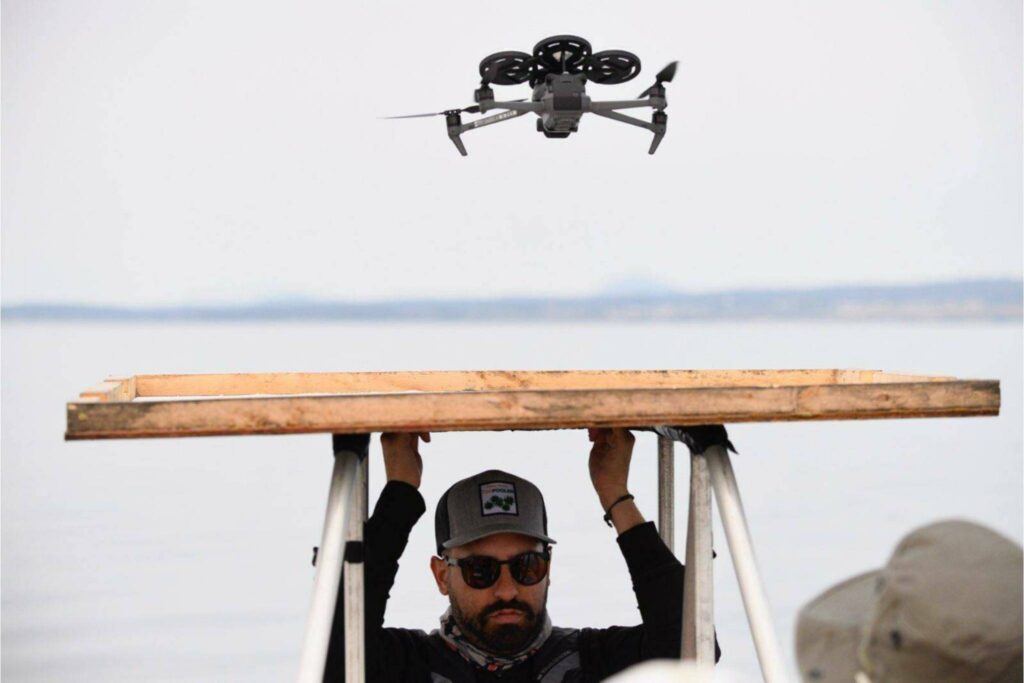By Luisa Loi / Whidbey News-Times
A group of scientists has transformed a dinghy into a mobile health clinic to assess the health of two beloved species: the southern resident killer whales and Bigg’s killer whales.
Over the past month, whale experts from the SeaDoc Society, the San Diego Zoo Wildlife Alliance and National Oceanic and Atmospheric Administration fisheries have been tracking down patients in the Salish Sea, armed with binoculars, directional microphones and a federal permit to approach and film the orcas with drones.
Between Sept. 5 and 7, the mobile health clinic paid a visit to the waters near Central Whidbey to examine some Bigg’s.
Around this time of the year, whenever they receive a sighting report from local whale enthusiasts and nonprofits like Orca Network, a team of wildlife veterinarians, molecular biologists and certified drone operators sails from Friday Harbor in hopes of catching the orcas on time and collecting some goo.
Crew members Joe Gaydos and Brad Hanson said they are mainly concerned about the health of the southern residents, which eat salmon. The Bigg’s population, an estimated 380 strong, seems to be healthy, with plenty of seals and sea lions to eat.
Gaydos is a marine wildlife veterinarian and the science director for the SeaDoc Society, while Hanson is a wildlife biologist at NOAA.
There are currently 74 southern resident killer whales left, a dramatic reduction from what NOAA scientists estimate may have been a population of about 140 at minimum before the 1960s, when many were captured and brought to marine mammal parks.
The population has become so vulnerable that if one gets sick, wildlife veterinarians might need to intervene with a dart gun of medicine.
“Even just losing one or two females can be a bad thing for the population,” Gaydos said.
This species also faces other challenges, such as less salmon, pollutants that may cause dysfunctions in their immune or reproductive systems and vessel traffic that might impact their ability to use echolocation and hunt, or lead to collisions and sometimes deaths.
The remote health assessments began a few years ago, Gaydos said, and are helping researchers refine their diagnostic tools to find and treat any potentially fatal conditions.
Back in 2018, 3-year-old southern resident Scarlet lost so much weight that scientists could see the shape of her skull where there would normally be a thick layer of fat. Due to her alarming state, NOAA authorized the first ever medical treatment of a wild killer whale, shooting the orca with a dart gun to inject her with antibiotics.
Sadly, it was too late for Scarlet, who passed away before her illness could be identified, Gaydos said in a video on the SeaDoc Society’s YouTube channel.
In the interview, Gaydos explained their job is similar to that of a physician conducting a routine exam to assess a human patient’s basic functions and overall health. But because whales are in continuous movement and can only be approached from a distance, the team needs to get creative.
Instead of taking a normal blood test, a drone operator in the crew flies a drone into the plume spraying out of an orca’s blowhole to collect breathing samples. The drone holds four petri dishes with a fluid that preserves the DNA collected, and the samples are then examined in a lab, Gaydos said.
Another drone equipped with a thermal camera looks into an orca’s blowhole and respiratory tract to check the animal’s temperature. Thermal cameras can also show unexpected hot spots that could indicate infections and skin lacerations, Gaydos and Hanson said.
Breath can also be used to assess heart health over time. Since they cannot use a stethoscope, researchers use a directional microphone — the long and fuzzy microphone used on movie sets — to capture the breathing sound of the orca and create a baseline to compare to a sample taken later. This could even show, for example, if an orca has developed asthma following a period of intense wildfires, Gaydos said.
Fecal samples, scooped up before they dissipate in the water, can be hard to immediately attribute to the right pooper, but a DNA test can help with that. By examining an orca’s poo, scientists can spot diseases and hormonal health, Gaydos said.
Drone footage can offer a better view of the orcas’ behavior, another indicator of their condition.
Last month, a southern resident orca that had never calved previously was seen with a baby, which Hanson said was a relief. Orcas typically reach sexual maturity at 15, and L90 Ballena became a mom at the age of 31.
Ballena has always stood out from the other females, being smaller and following unusual routes by herself. Some mothers, Hanson said, will leave their calf in the care of the pod in order to hunt, but because she doesn’t follow the rest of the pod, she has to take care of her baby by herself. Still, drone footage has shown some hunting behavior, meaning that she is eating.
The best time to spot southern residents is September, which is when the expeditions take place. Gaydos said the hope is to eventually develop more reliable tools that would allow other organizations to conduct year-round examinations.
SeaDoc, the San Diego Zoo and NOAA aren’t the only groups examining the health of orcas. Every year, the nonprofit SR3 SeaLife Response, Rehabilitation, and Research shares information about which southern residents are in bad shape based on drone images.
Between June 2023 and May 2024, out of 40 photographed, SR3 identified 14 killer whales with a higher mortality risk, including two juveniles, six adult females and two adolescent females.
According to a 2021 study titled “Survival of the fattest: linking body condition to prey availability and survivorship of killer whales,” an orca’s body condition can be assessed by examining the white eye patches. Researchers measure the distance in pixels between the anterior end of the eye patch and the distance between the eye patches at 75% or their length. Skinny whales have a lower eye patch ratio, as they have lost fat behind their skull.
About 80% of a southern resident’s diet consists of Chinook salmon, which is listed as threatened under the Endangered Species Act, according to NOAA. With 138 different vertebrate species depending on salmon, orcas included, Gaydos said salmon restoration efforts are crucial.
Humans, orcas and other living creatures are all connected, he said.
“They are our neighbors,” Gaydos said. “We kind of owe them to take care of this place where we all live.”
This story originally appeared in the Whidbey News-Times, a sibling publication to The Herald.
Talk to us
> Give us your news tips.
> Send us a letter to the editor.
> More Herald contact information.


























